- Reclamation
- News & Multimedia
- News Stories
- WYAO Rope Access Team Addresses Rock Scaling Issues at Guernsey
WYAO Rope Access Team Addresses Rock Scaling Issues at Guernsey
Written by: Jay Dallman, WYAO
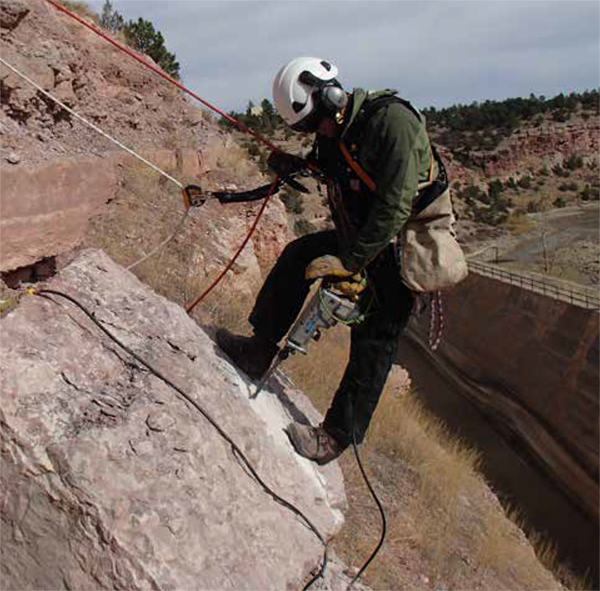
Mark Ronca drilling anchor holes in limestone slab.
The Wyoming Area Office (WYAO) rope team was mobilized in late October 2016 to address a number of Operation and Maintenance (O&M) recommendations at Guernsey Dam. The two main concerns related to potential rock fall hazards on the downstream side of the dam. One large slab of limestone was threatening the concrete chute of the North Spillway and another was perched precariously above the power plant main entrance. The WYAO rope team consisted of Nathan Morgan - Civil Engineer, Nathan Harp – Electrical Engineer, Mark Ronca - Mechanic, and Bryan Nyffeler – Alcova/Fremont Power Plant Supervisor. Mark Neeley - Geologist (Upper Colorado, Salt Lake City Office) joined the team to provide his expertise in geology and rope team operations.
The Guernsey Dam North Spillway left rock face is made up of relatively flat lying rock formations, however, a loose slab of limestone rock approximately 120 feet above the center of the spillway chute floor separated from the main formation and started to move down the slope. The slab, weighing approximately 5 to 6 tons, posed a threat to the integrity of the 18-inch-thick concrete floor and walls of the spillway, as well as the drain directly below the spillway floor. Trying to remove it intact would be complicated and expensive. Attempting to blow it into smaller pieces for removal could result in damage to the spillway, if too large a piece fell into the concrete chute. In this case, it was decided to arrest the loose slab in place on the slope rather than attempt to remove it.
Since there were no available anchors on the hill above the North Spillway, vehicle frames were used as independent anchors for each member of the two man crew working atop the rock. Four 22-inch-deep anchors were installed in the boulder, as well as two anchors, 20 feet to the left and right sides of the limestone slab using an electric drill. The engineered anchors would allow for two wire rope lines to support the rock vertically from the hillside above, as well as one horizontally across the boulder to the in-situ limestone formation. Smaller fragmented rock material on the fractured hillside and slope proved to be a hazard to the rope team, requiring the rope team members to scale loose material above, and near the work area. Small amounts of materials did accumulate in the spillway chute, but it was not considered a threat to the integrity of the spillway.
The horizontal wire rope was tensioned across the lower boulder face to help reduce outward movement. Six pieces of iron rebar were drilled into the rock in front of the toe of the limestone slab to increase sliding friction. Two separate wire ropes were installed with two anchors securing each vertical line to the slab. Each wire rope ran approximately 50 feet above to a six foot angle iron post driven perpendicularly into the top of hillside. The cables were tensioned, and a third post was placed as a backup anchor.
For the large slab (approximately 8 tons) situated directly above the power plant main entrance, it was decided to remove the boulder using controlled blasting to break it into smaller pieces. The largest concern for the rope team was protecting the power plant and plant parking area from rock fall. A secondary concern was the potential for large pieces of the rock breaking free and damaging the historic hand rail below. An abandoned Guernsey State Park 4-inch irrigation water pipe had to be removed from the work area since it bent at 90 degrees directly below the rock and proved to be a hazard to the workers. Four sheets of plywood were placed along the top of the hand railing to prevent stray chips and large chunks from flying down into the power plant and parking area. The rope team removed portions of the rock periodically throughout the day using a product known as Boulder Buster. The process involved drilling holes in the rock, setting controlled charges in the holes and covering the rock with a protective blast mat to keep fragments from becoming airborne. The process worked well and pieces piled-up and landed successfully in front of the hand railing where they could be further processed and removed.
Ultimately, the rope team proved to be a good example of interdisciplinary cooperation, and their efforts successfully mitigated hazards which threatened the safety of their fellow employees as well as the integrity of important Reclamation structures.

Mark Neely roping down a slab above Guernsey North Spillway.
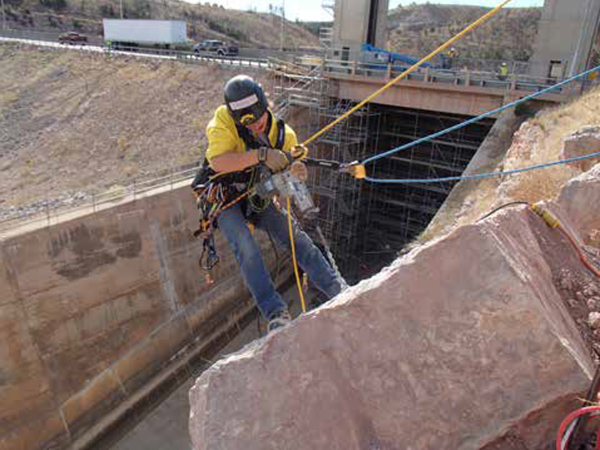
Nathan Morgan taking a turn at drilling.
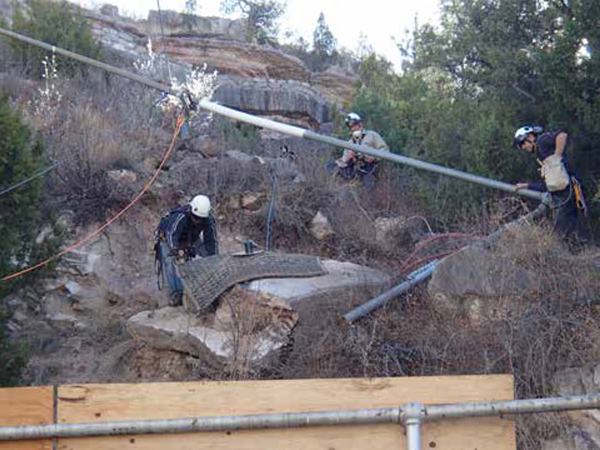
(L to R) Nathan Harp, Bryan Nyffeler, and Mark Ronca, prepare a Bolder Buster Charge in a slab above the power plant.
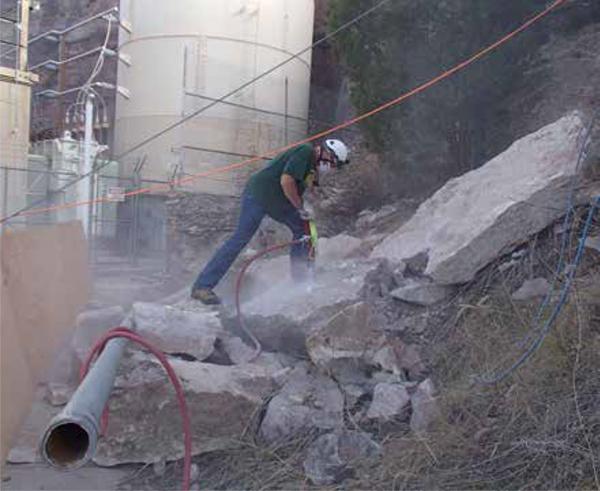
Bryan Nyffeler drills larger fragments for more blasting.
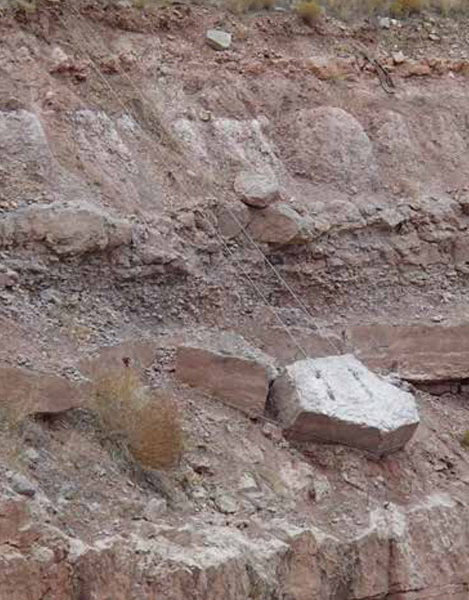
Limestone slab over Guernsey Dam North Spillway.
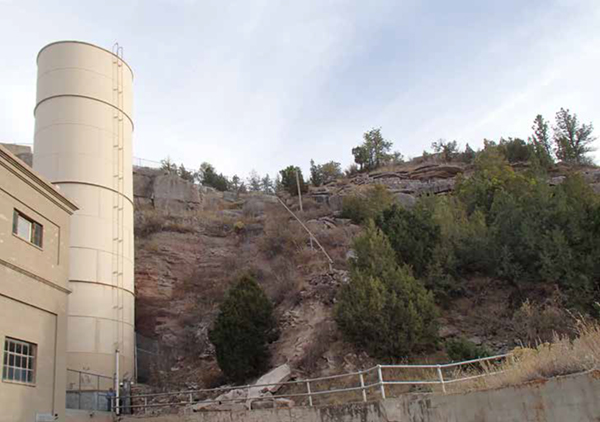
Large limestone slab above the Guernsey Power Plant entrance.
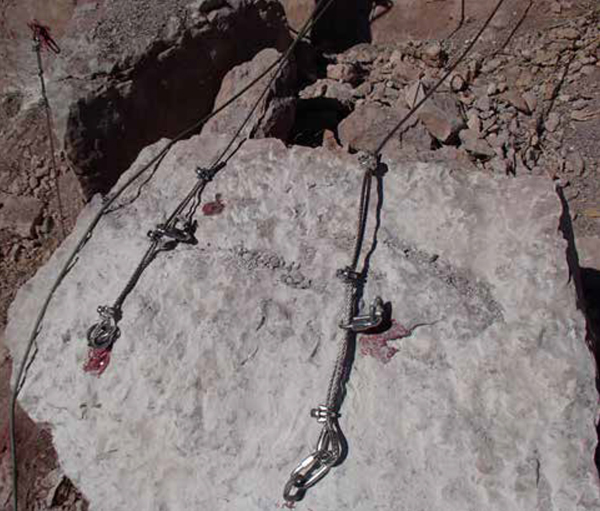
Rock slab over the spillway with epoxy grouted anchors.
Published on January 11, 2017

